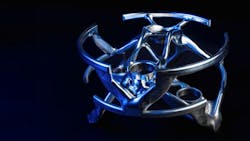NASA Envisions Design Differently
The idiom “a fresh pair of eyes” means looking at something with a new perspective, which can often lead to new ideas and solutions. What if this approach for part design came from a computer and all that was needed is to feed the computer a few critical specifications and design must-haves? Would users trust this fresh perspective? The National Aeronautics and Space Administration (NASA) does. They see it is the way of the future and have taken a giant leap toward this new approach to part design.
NASA’s Mission for a Moon Assembly
Pushing the envelope is in NASA’s DNA. At a recent PowerSource Global Summit, NASA engineers challenged attendees to develop the parameters and constraints needed to generatively design a metal frame. The aim was for this assembly to hold a vessel that could capture volatile gases from the surface of the moon.
Being the moon, the assembly had to endure temperatures that could skyrocket from −315° F to −55° F, only to return to ultra-absurd cold after sundown. There were space and weight considerations to conquer, and incorporating an efficient stackable design could allow for multiple units to make the journey.
Equally important was the part’s stability. The moon’s surface isn’t always as smooth as glass, so the part had to be designed to withstand slopes. Top of mind: NASA wanted quick turnaround so engineers could see the fruits of their labors—and get the emotional charge that comes from a completed part.
About Generative Design
With generative design, users let the design program know any constraints they may be facing (dimensions, special geometries, etc.) With that knowledge, the computer comes up with a solution that might be considerably different from what a human designer would create. Sometimes, that’s for the better.
The other advantage of generative design is that it can provide multiple solutions quickly. Each can be evaluated in CAD form or prototyped to compare physical options. Key to all of this is the speed at which this happens.
READ MORE: Closing the Generative Design Gap
Cutting Aluminum…and Time
Informed by the efforts of the NASA engineers and the crowdsourced knowledge of the attendees, the final design was complete and uploaded to the Protolabs digital production systems in less than 10 hours, ready for CNC milling. The AI-informed design simplified access for the mills to do their work, ultimately yielding a design that allowed for straightforward two-axis milling.
Automated tool-pathing software and input from Protolabs engineers completed the pre-game show. Then, a block of lightweight, temperature-tolerant aluminum 6061 was fixtured into a mill to start the physical part-making process.
Previously, the software accurately calculated that it would take about 19 hours to machine the part and another four hours of processing. The part was completed and ready for shipping at 4:31 p.m. the next day. It arrived a few hours before that day’s meetings.
READ MORE: Generative Design, Artificial Intelligence and Manufacturing
From CAD Upload to the Big Reveal
After the part’s overnight journey from Minnesota to Florida, a group of ecstatic NASA engineers were able to see and touch the part, having taken just 36 hours from when the initial CAD file was uploaded. Best of all, they were able to show it off to the attendees and even put it to work that day, collecting sublimated dry ice (gaseous carbon dioxide) in the same way it would operate on the moon as part of the Artemis mission. It was a stunning bit of collaboration between NASA and Protolabs.
Looking to the future, this sort of workflow will become more commonplace, if not standard. The speed and novel approaches that generative design brings to the table are informed by people, but not delimited by them. The future is now, for those bold enough to take the step forward.
About the Author

Chris Gottlieb
Team Leader, CNC Product Management
Chris Gottlieb brings more than 25 years of manufacturing experience to Protolabs with knowledge in multiple industries, including automation and automotive. Having started as a calibration engineer in Detroit, Gottlieb has a passion for systems engineering and optimization in technical fields. She brings a customer needs perspective to the Protolabs organization while leading the CNC product management team.


